Looking for email platforms that integrate seamlessly with your business tools? Here's a breakdown of the top 10 email platforms offering robust API integrations to simplify workflows, automate processes, and enhance connectivity across your tech stack. Whether you're managing e-commerce, CRM, or marketing automation, these platforms have you covered:
- Moosend: Developer-friendly API with over 80 integrations, including Shopify and Zapier.
- MailerLite: Easy-to-use RESTful API with 100+ app integrations like Shopify, HubSpot, and Google Sheets.
- ActiveCampaign: Advanced RESTful API with 940+ connections, supporting complex automations.
- Mailchimp: Unified APIs for marketing and transactional emails, integrating with 8,000+ apps via Zapier.
- HubSpot: Extensive CRM-focused API with over 1,000 integrations, including Salesforce and Google Analytics.
- Constant Contact: Reliable v3 API with 300+ integrations for small business tools and e-commerce.
- Sendinblue (Brevo): Multi-channel API supporting email, SMS, and chat with 319+ integrations.
- SendGrid: High-volume transactional email API with strong security and 30,000 emails/second capacity.
- Maileroo: API-first platform offering scalable plans and GDPR-compliant servers in Europe.
- Campaign Monitor: RESTful API with pre-built integrations for Salesforce, WordPress, and Shopify.
Quick Comparison
| Platform | Key Features | Integration Highlights | Authentication Methods |
|---|---|---|---|
| Moosend | 80+ integrations, XML/JSON API | Shopify, Zapier, WordPress | API Keys, OAuth 2.0 |
| MailerLite | RESTful API, user-friendly docs | Shopify, HubSpot, Google Sheets | API Keys |
| ActiveCampaign | 940+ integrations, automation focus | Salesforce, CRMs, webhooks | API Keys, OAuth2 |
| Mailchimp | Marketing/Transactional APIs | Shopify, Analytics, Zapier | API Keys, OAuth2 |
| HubSpot | CRM-centric, 1,000+ integrations | Salesforce, Google Analytics, CMS | API Keys, OAuth2 |
| Constant Contact | Cloud-hosted v3 API, 300+ tools | QuickBooks, Zapier, Salesforce | API Keys, OAuth 2.0 |
| Sendinblue | Multi-channel API, 319+ integrations | SMS, Stripe, WordPress | API Keys, OAuth2 |
| SendGrid | High-volume, 99.984% uptime | AWS, Salesforce, Zapier | API Keys |
| Maileroo | Scalable, GDPR-compliant servers | REST API focus | API Keys |
| Campaign Monitor | RESTful API, webhook support | Salesforce, Shopify, WordPress | API Keys, OAuth |
These platforms streamline email marketing and data management through powerful APIs, making them ideal for businesses of all sizes. Dive into the specifics to find the right fit for your needs.
Email API Explained - Tutorial by Mailtrap

1. Moosend
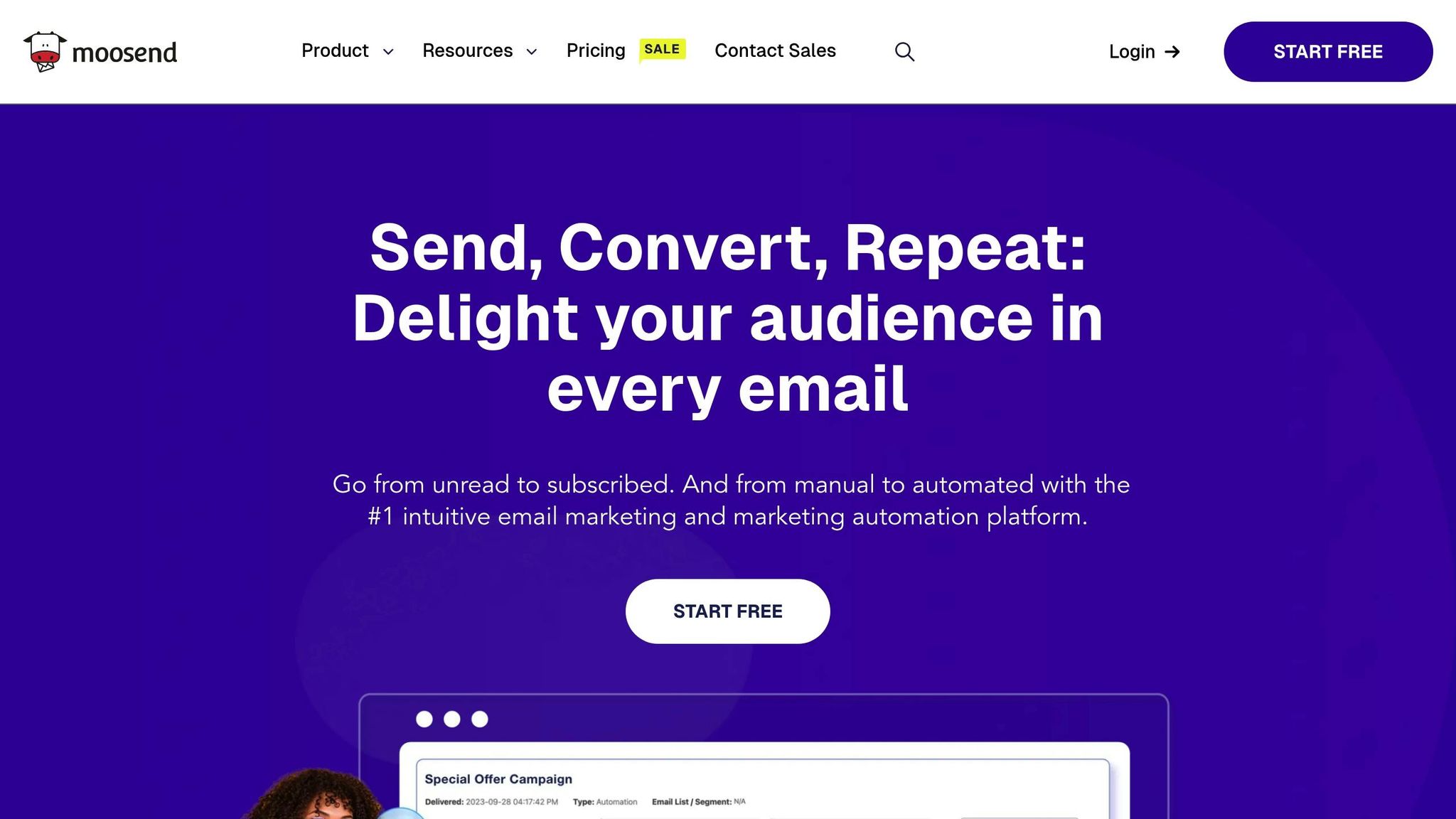
Moosend presents itself as a developer-friendly email marketing platform, offering robust API capabilities that integrate seamlessly with its infrastructure. This allows businesses to manage email lists, subscribers, campaigns, and segments programmatically. With over 80 integrations available, Moosend is a solid choice for businesses looking to connect their marketing tools effectively.
API Documentation Quality
Moosend's API documentation lays out clear and detailed instructions for developers aiming to incorporate email marketing features into their applications. It covers essential topics like authentication, request parameters, and HTTP status codes. The documentation also includes step-by-step guides for common tasks, such as creating email lists and adding subscribers via API.
The API supports both XML and JSON response formats, giving developers flexibility in how they handle data. Authentication is managed through a unique API key for each account, with specific instructions provided on obtaining and securely using these keys. A particularly helpful feature is the explanation of API rate limiting, which ensures system stability by controlling the frequency of requests. Additionally, the use of standard HTTP methods (GET, POST, DELETE) is illustrated with practical examples, making the documentation accessible to developers of varying experience levels.
Integration Breadth (Third-Party Tools and Platforms)
Moosend offers a wide range of integrations with various business tools, including webinar platforms and email verification services. For instance, it connects with BigMarker to streamline webinar marketing by automatically sharing registration contacts and exporting attendee data to Moosend email lists. It also integrates with Clearout to verify email addresses, ensuring invalid contacts are unsubscribed automatically for better list hygiene.
For e-commerce and lead generation, Moosend works with tools like Convertful to create list-building widgets and OptiMonk to capture visitor email addresses. It also integrates with WordPress, allowing users to effortlessly import Moosend-designed landing pages into their websites. Broader connectivity is achieved through Zapier, which enables access to hundreds of additional apps via automated workflows. Additionally, Latenode provides another way to create marketing workflows triggered by specific business events.
Developer Support and Resources
Moosend offers a variety of resources to support developers, including comprehensive documentation, a knowledge base, video tutorials, webinars, and live chat. The live chat feature provides real-time technical assistance, ensuring quick resolutions to issues. The platform also emphasizes security best practices, encouraging developers to assign minimal permissions to API keys, rotate them regularly, and implement robust error-handling mechanisms. Thorough integration testing is also recommended before deployment.
Scalability and Authentication Methods
Moosend's API is designed to handle growth effectively, employing rate limiting to maintain performance as demands increase. Authentication is managed through unique API keys for each account, offering a secure and straightforward method of access. The API also supports automation of complex workflows, such as adding new e-commerce customers to targeted email lists based on purchase behavior, syncing leads from Moosend forms directly to CRM systems, and triggering follow-up emails after resolving support tickets. These features make it a scalable solution that adapts to evolving business needs.
Next, we’ll take a closer look at MailerLite’s API integrations and how they enhance marketing connectivity.
2. MailerLite
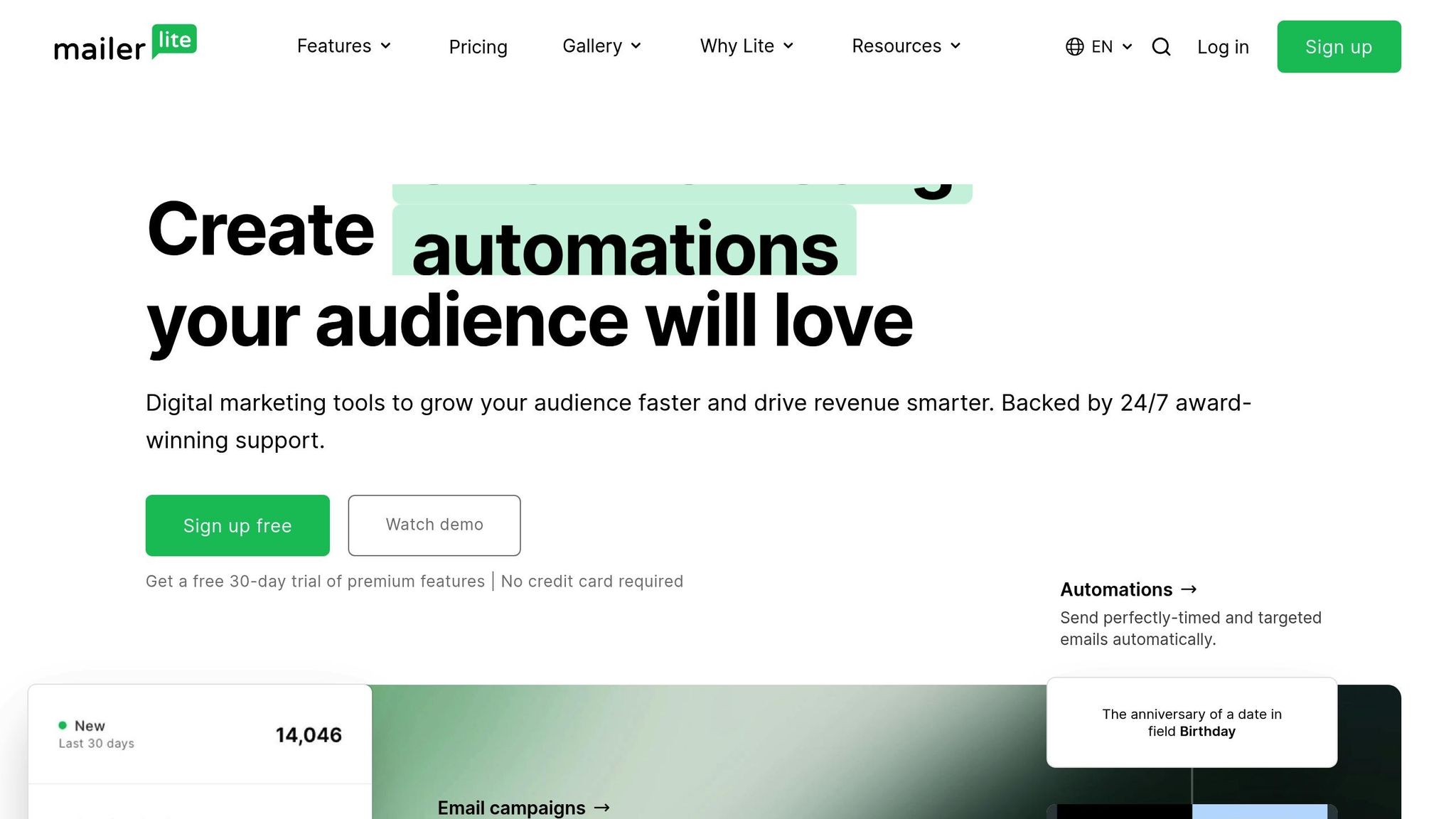
MailerLite strikes a balance between simplicity and powerful features, catering to over 1 million users worldwide. Its RESTful API allows for smooth integration with external applications, enabling automated data exchange for streamlined marketing efforts.
API Documentation Quality
MailerLite's API documentation stands out for being user-friendly, making it accessible to both developers and non-technical users. The clear instructions and step-by-step guides help small and medium-sized businesses implement custom integrations without unnecessary hassle.
Integration Breadth (Third-Party Tools and Platforms)
MailerLite connects with over 100 apps, offering wide compatibility through its Integrations page. It supports popular e-commerce platforms like Shopify and WooCommerce, CRMs such as Kommo, Pipedrive, Salesflare, Zoho CRM, Microsoft Dynamics 365, HubSpot, and Salesforce, as well as payment systems like Stripe. Additional tools include Google Sheets, Facebook Lead Ads, Typeform, Calendly, Eventbrite, Canva, and a WordPress plugin for website builders. For enhanced automation, MailerLite works seamlessly with tools like Zapier, Make, and LeadsBridge.
Developer Support and Resources
The platform provides categorized API documentation and detailed guides that make integration straightforward, regardless of a team's technical expertise.
Scalability and Authentication Methods
MailerLite offers robust security and scalability features. For custom domains, it requires domain authentication, either through automatic detection or manual DKIM/SPF setup. It also provides multiple user permission levels, two-factor authentication, and IP restrictions. To ensure secure and reliable email delivery, MailerLite recommends implementing a DMARC policy for large-scale senders. The platform uses dedicated sending domains like mlsend, mlsend2, and mlflow, and offers detailed domain authentication guides for providers such as GoDaddy, Bluehost, Cloudflare, and Squarespace.
Up next, dive into how ActiveCampaign's API ecosystem powers advanced marketing automation.
3. ActiveCampaign
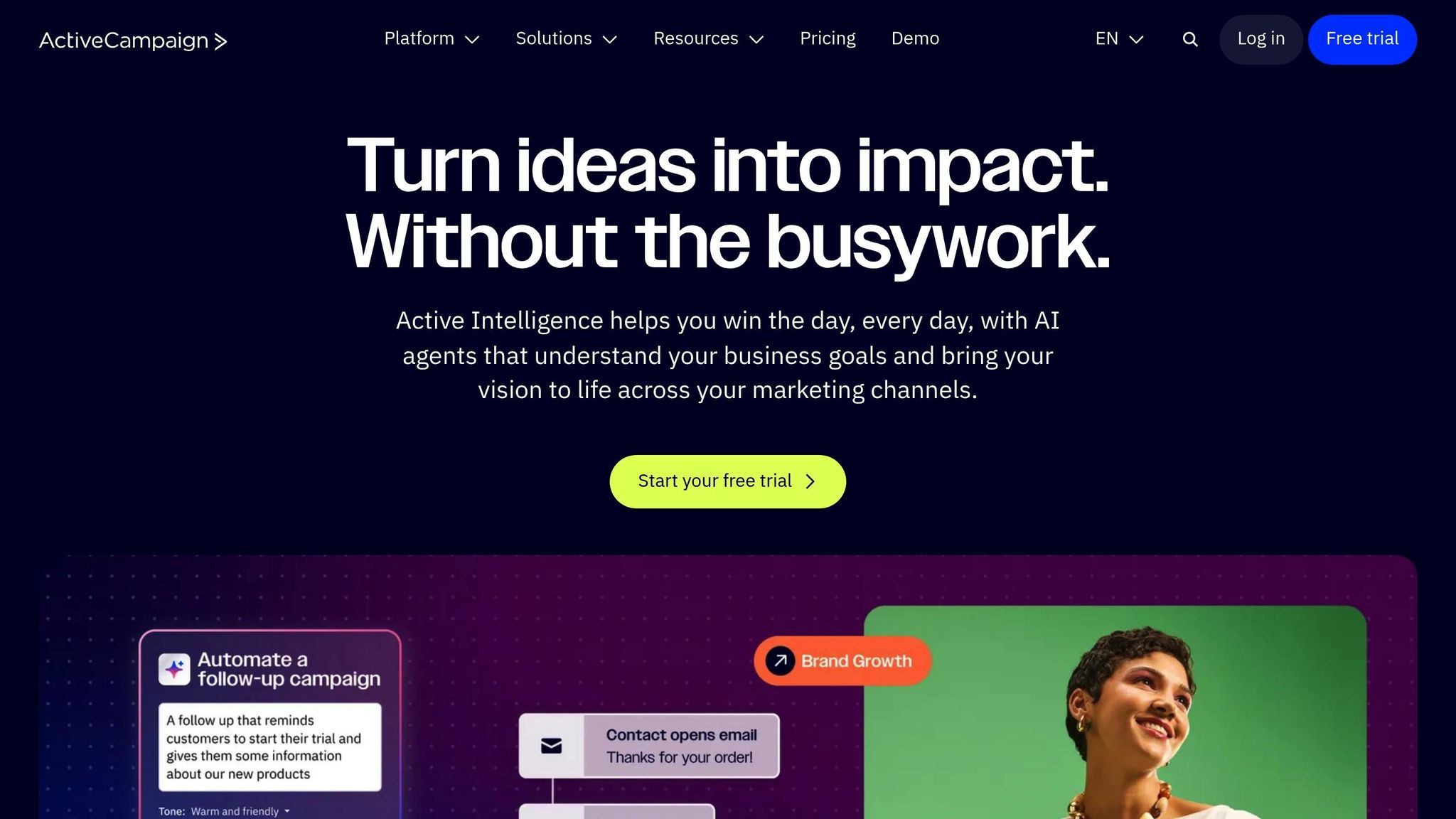
ActiveCampaign is a powerhouse when it comes to advanced marketing automation. With its versatile API ecosystem, it connects with over 940 apps, enabling smooth data sharing across platforms. Its RESTful API architecture allows businesses to sync contact data, trigger automations, and manage campaigns all through programmatic solutions.
API Documentation Quality
ActiveCampaign's RESTful API (version 3) is packed with modern features, many of which are exclusive to this version. The documentation is developer-friendly, offering a detailed portal with clear method overviews. The API is designed around REST and HTTP principles, delivering responses in JSON or XML formats. For those who aren't coding experts, the platform also includes an App Studio, which lets users create custom data workflows with minimal technical skills.
Integration Breadth (Third-Party Tools and Platforms)
The API goes far beyond simple contact syncing. It can handle tasks like syncing contact information, adding contacts to automations, creating and sending campaigns, and analyzing performance data across connected tools. Additionally, it supports real-time automation by allowing third-party platforms to send data via webhooks whenever new events occur.
Developer Support and Resources
ActiveCampaign ensures developers have the tools they need to succeed. It supports multiple authentication methods, including API Key, OAuth2, Basic Auth, Token Auth, and Session Auth. Error handling is straightforward, using standard HTTP status codes like 403 (authentication issues), 404 (resource not found), 422 (unprocessable request), and 429 (rate limiting) to help developers quickly identify and resolve issues. Every user gets a unique API key, and the platform emphasizes secure API practices.
Scalability and Authentication Methods
To maintain system stability, ActiveCampaign enforces a rate limit of 5 requests per second per account. For businesses needing more flexibility, custom rate limit solutions are available through support channels. Developers can optimize their API usage by caching data and combining operations. If an API key is ever compromised, users can easily reset it via the Developer Settings page in their account.
4. Mailchimp
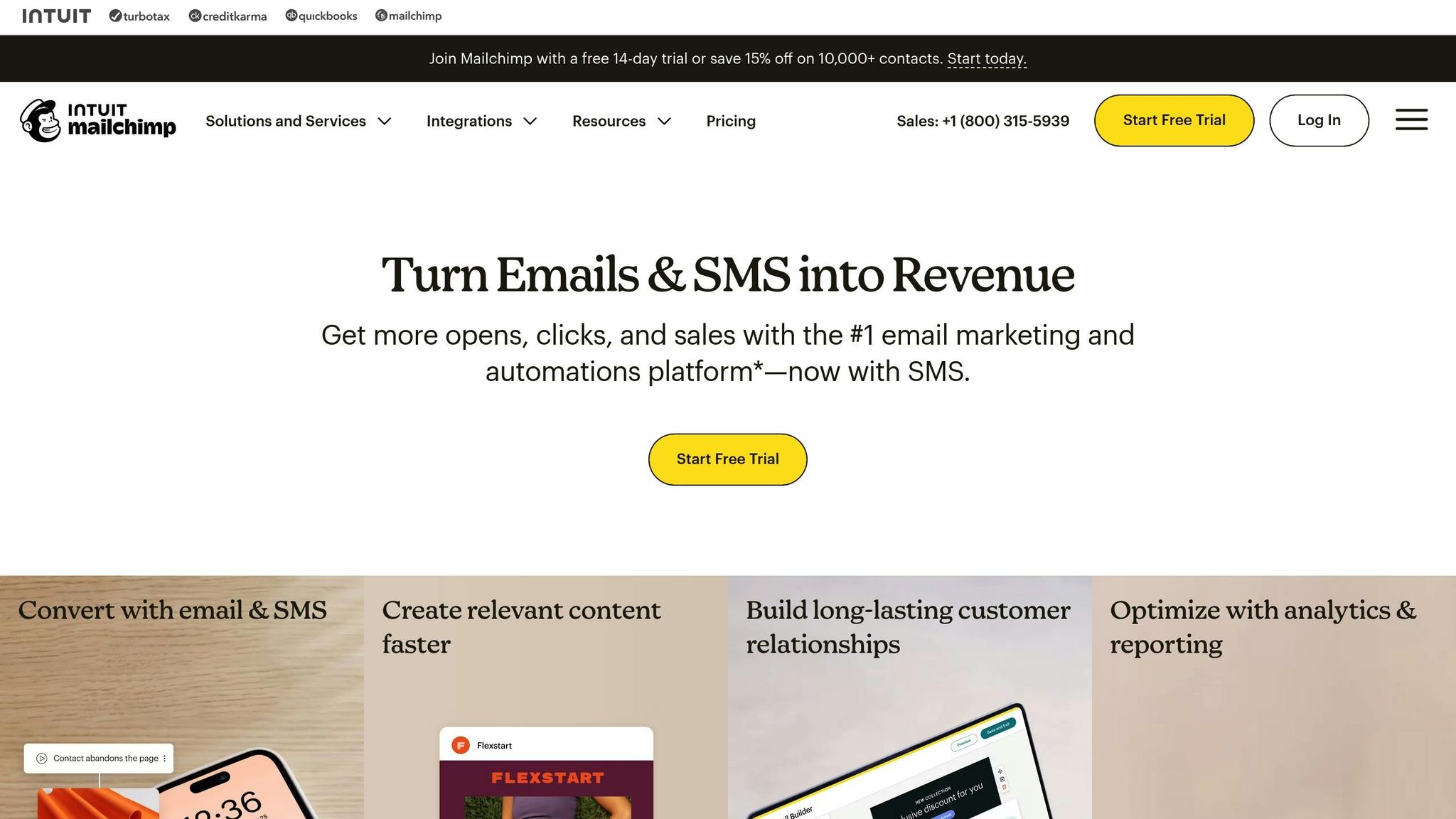
Mailchimp is one of the most well-known names in email marketing, offering both Marketing and Transactional Email APIs (previously known as Mandrill) to support seamless integration. The platform has also worked on creating a unified developer experience by consolidating its tools into a streamlined interface.
API Documentation Quality
Mailchimp's Marketing API documentation stands out as a benchmark in the industry. It provides clear, detailed descriptions, step-by-step tutorials, and an intuitive layout that makes it easy for developers to find what they need. Using the OpenAPI Specification, the documentation outlines endpoints and includes interactive code snippets, making the process of understanding and implementing the API much simpler. These features make Mailchimp's documentation especially helpful for developers aiming to leverage its integration capabilities.
Integration Breadth
Mailchimp boasts an extensive integration ecosystem, connecting with a wide range of third-party tools in areas like analytics, e-commerce, social media, and customer service. For instance, Zapier enables Mailchimp to interact with over 8,000 web apps. Additionally, the platform offers direct integrations with popular tools such as Shopify, Salesforce, WordPress, WooCommerce, HubSpot, Google Analytics, Facebook, Pipedrive, and Eventbrite. This array of integrations highlights Mailchimp's ability to adapt to various business needs. Beyond these connections, the platform supports developers with dedicated resources to ensure smooth implementation.
Developer Support and Resources
Mailchimp actively supports its developer community through initiatives like a dedicated fund and unified developer products. For those looking to become partners, the Integration Partner Program provides clear guidelines. Requirements include building on the latest Marketing API version, supporting OAuth2 authentication, and maintaining at least 25 active users within the past 90 days. These standards help ensure that integrations remain reliable and effective.
Scalability and Authentication Methods
Mailchimp's pricing model is based on the number of contacts, allowing businesses of all sizes to scale their usage without compromising API performance.
To protect user data, Mailchimp employs TLS 1.2+ encryption, hashed passwords, and brute force protection for logins and API access. The platform also includes two-factor authentication (2FA) for added security and supports email authentication protocols like SPF, DKIM, and DMARC, simplifying the process for users to secure their email communications.
"Intuit Mailchimp takes data security and privacy very seriously, and we recognize that our security measures and practices are important to you."
5. HubSpot
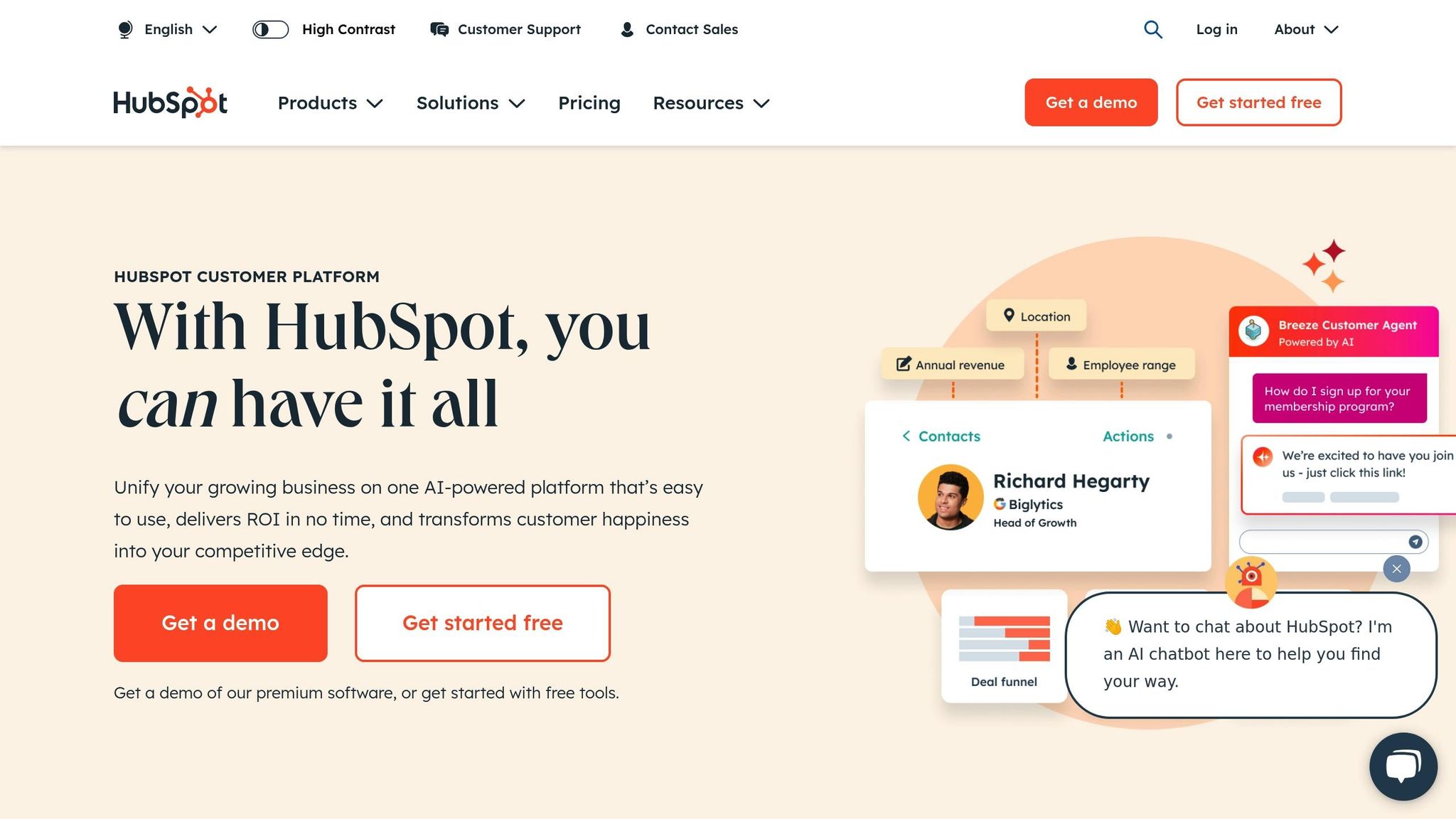
HubSpot brings together a powerful CRM system with extensive API integrations, making it easy to connect email campaigns with larger marketing strategies. Let's break down how HubSpot's API documentation, diverse integrations, developer resources, and scalable security measures make it stand out.
API Documentation Quality
HubSpot provides developers with well-structured and detailed documentation. Its APIs follow REST principles, using consistent URL patterns and standard HTTP methods for straightforward implementation. The documentation includes a complete list of endpoints, interactive code blocks, and sample requests in multiple programming languages. Developers can even test API calls directly using OAuth or private app tokens, thanks to the "Run in Postman" feature. Comprehensive guides walk users through common use cases, and an active changelog keeps developers informed about updates and new features.
Integration Breadth
HubSpot's integration ecosystem is vast and versatile. The HubSpot App Marketplace boasts over 1,000 integrations, spanning areas like sales, marketing, customer service, and project management. For e-commerce, integrations with Shopify and WooCommerce help businesses manage online sales and customer data. Tools like ClickUp, Monday.com, and Asana streamline project management tasks. Analytics integrations with Google Analytics and SEMrush offer deeper insights, while creative tools like Canva and SurveyMonkey support content creation and customer feedback. Professional services teams can benefit from specialized tools like ConnectWise, Autotask, and Accelo, which sync project management and service delivery with HubSpot's CRM. These integrations enhance email campaign automation and precision, making HubSpot a go-to for marketers.
Developer Support and Resources
HubSpot nurtures its developer community with resources like forums and a dedicated Slack channel, where developers can share insights, solve problems, and collaborate on projects. For teams working on custom website solutions, HubSpot offers comprehensive CMS developer documentation, showcasing the platform's flexibility well beyond email marketing.
Scalability and Authentication Methods
HubSpot ensures scalability by offering generous API limits that grow with your business needs. Professional and Enterprise users benefit from a 50% increase in burst limits (up to 150 API calls every 10 seconds) and daily limits of up to 500,000 requests. For businesses requiring even more capacity, an API Add-On extends these limits to 1,000,000 requests and 200 burst calls per 10 seconds.
On the security front, HubSpot uses OAuth 2.0 for public applications and private app tokens for server integrations. OAuth 2.0, favored by 84% of developers, is ideal for apps requiring delegated permissions, while private app tokens are suited for server-to-server setups. Some configuration APIs also utilize developer API keys.
| Authentication Method | Use Case | Security Features |
|---|---|---|
| OAuth 2.0 | Public apps with user interaction | Automatic token deactivation; GitHub secret scanning |
| Private App Access Tokens | Server-to-server integrations | Secure token storage; IP whitelisting support |
| Developer API Keys | App configuration APIs | Environment variable storage recommended |
HubSpot takes security seriously, with measures like automatic token deactivation and GitHub's secret scanning to detect and disable exposed credentials. The platform also complies with GDPR and CCPA regulations, ensuring its API integrations meet international data protection standards.
6. Constant Contact

Constant Contact offers an API platform designed to seamlessly integrate email marketing with broader business operations. Its API infrastructure prioritizes reliability and ease of use, enabling businesses to automate marketing workflows without needing advanced technical expertise.
API Documentation Quality
Constant Contact provides detailed and well-organized API documentation built on HTTP protocols and REST design principles, with support for JSON data exchange to ensure smooth integration. While the older v2 API is still available, the cloud-hosted v3 API is recommended for better performance and reliability. The documentation includes specifics on data formats, HTTP methods, date and time standards, encoding details, and pagination. Each API endpoint page provides information on HTTP response codes and sample JSON payloads, making it easier for developers to understand and implement.
To simplify development and troubleshooting, Constant Contact offers an API Tester tool powered by Mashery's I/O Docs. This tool allows developers to create JSON payloads, test API calls, and view real-time responses. A centralized developer portal provides access to documentation, code samples, and API key management. Additionally, a community forum is available for ongoing support and collaboration. These resources contribute to the platform's robust integration capabilities.
Integration Breadth
Constant Contact supports a wide range of integrations, connecting with over 300 apps to help businesses synchronize contacts, expand their reach, and create engaging content. These integrations include both native options and partnerships with third-party tools. For example, the Zapier integration links Constant Contact to more than 8,000 other apps, opening up countless automation opportunities for various business functions.
Key integrations include Salesforce, which facilitates better data sharing between marketing and sales teams, and QuickBooks, which automates tasks like tracking campaign expenses and generating invoices based on customer actions. This extensive ecosystem ensures that businesses can tailor their workflows to meet their specific needs.
Scalability and Authentication Methods
The v3 API is cloud-hosted, offering enhanced stability and performance. It includes bulk activity features, making it easier to handle large volumes of contacts, lists, and tags efficiently. Testing has shown a 40% reduction in payload sizes (excluding subresources), resulting in faster data transfers.
Authentication is managed through OAuth 2.0 with JWT, short-lived tokens, CORS, and PKCE, ensuring secure access. Both client-side and server-side authorization flows are supported, with the server flow utilizing refresh tokens for extended access. To maintain stability and prevent misuse, rate limits are set at 10,000 requests per day and 4 requests per second per API key. Additionally, the platform's scope system allows developers to limit access to specific user data and API endpoints, ensuring clear boundaries for data and functionality requests.
| API Version | Authentication | Key Features | Performance Benefits |
|---|---|---|---|
| V3 API | OAuth 2.0 with JWT | Cloud-hosted; bulk operations; CORS support | 40% smaller payloads; improved stability |
| V2 API | OAuth 2.0 | Server and client flow support | Predictable URLs; standard HTTP codes |
The v3 API reflects Constant Contact's focus on modern development practices, featuring a RESTful design and JSON payloads across nearly all endpoints. With the v2 API being phased out, businesses are encouraged to transition to v3 for better performance, enhanced security, and access to the latest features.
sbb-itb-6e7333f
7. Sendinblue (now Brevo)

Brevo, previously known as Sendinblue, has grown into a full-fledged marketing automation platform since its launch in 2012. Its API infrastructure supports a variety of communication channels, including email, SMS, and chat, making it a solid choice for businesses aiming to streamline multi-channel marketing efforts. This multi-tool connectivity is a key feature for modern email marketing strategies.
API Documentation Quality
Brevo's API documentation is well-organized and easy to follow. It operates on a versioned endpoint system, with v3 being the most current version, accessible through HTTPS requests. Each request requires a JSON payload accompanied by headers like content-type: application/json and an api-key.
The documentation includes examples in multiple programming languages and provides dedicated GitHub SDKs, ensuring compatibility with various development environments. This flexibility allows teams to work in their preferred languages without any hassle.
Error handling is another strong point, with clear HTTP response codes and detailed error objects that include both error codes and descriptions. The API also supports rate limiting and pagination, which are crucial for handling large-scale operations efficiently. Standardized JSON response formats make it easy to parse and work with data across different systems.
Integration Breadth
Brevo offers an extensive range of integrations, connecting with tools across various business sectors. For CMS and e-commerce platforms, it integrates with PrestaShop, WooCommerce, Shopify, Magento, nopCommerce, and WordPress. In the CRM space, it connects with systems like SugarCRM, Salesforce, Pipedrive, Zoho CRM, Zenkit, and Microsoft Dynamics CRM.
The platform also supports payment services such as Stripe and PayPal, alongside lead generation tools like Facebook Lead Ads, Gleam, OptinMonster, WisePops, Personizely, and Poptin. For helpdesk solutions, integrations include Intercom and Live Help Now. Additionally, Brevo links with email creation tools such as Google Analytics, Stripo, Nosto, Hyperise, NiftyImages, and AcyMailing.
ApiX-Drive further expands Brevo's capabilities by offering 319 integrations with other platforms, enhancing automation options. As of October 2023, InboxArmy.com highlighted Brevo's ability to sync website content, including blog posts and landing pages, with its email marketing tools. This feature allows businesses to craft and send tailored email campaigns based on user interactions.
Scalability and Authentication Methods
Brevo provides two secure authentication methods: API key and OAuth. Each method is tailored to different use cases, ensuring flexibility and safety.
- API Key Authentication: Ideal for simpler integrations, this method uses unique keys - each at least 30 characters long - passed in the authorization header of API requests. It's straightforward and effective for basic applications.
- OAuth Authentication: Recommended for enterprise-level apps or marketplace plugins, OAuth combines authentication and authorization in one flow. It uses tokens with defined expiration periods, providing enhanced security while reducing development complexity.
| Authentication Method | Best Use Case | Key Features | Security Level |
|---|---|---|---|
| API Key | Simple integrations | 30+ character keys; direct header use | Standard |
| OAuth 2.0 | Enterprise apps/plugins | Token-based; time-limited validity | Enhanced |
To maintain security, Brevo advises assigning unique API keys for each integration, storing keys securely, and promptly deleting unused ones. Since API keys grant full account access, they should be safeguarded like passwords.
All API requests are conducted over HTTPS, ensuring secure data transmission. Brevo also uses version-specific endpoint URLs (e.g., https://api.brevo.com/v3/) to guarantee clear version control and smooth development processes.
Next, we’ll explore how SendGrid utilizes API integrations to enhance email marketing workflows.
8. SendGrid
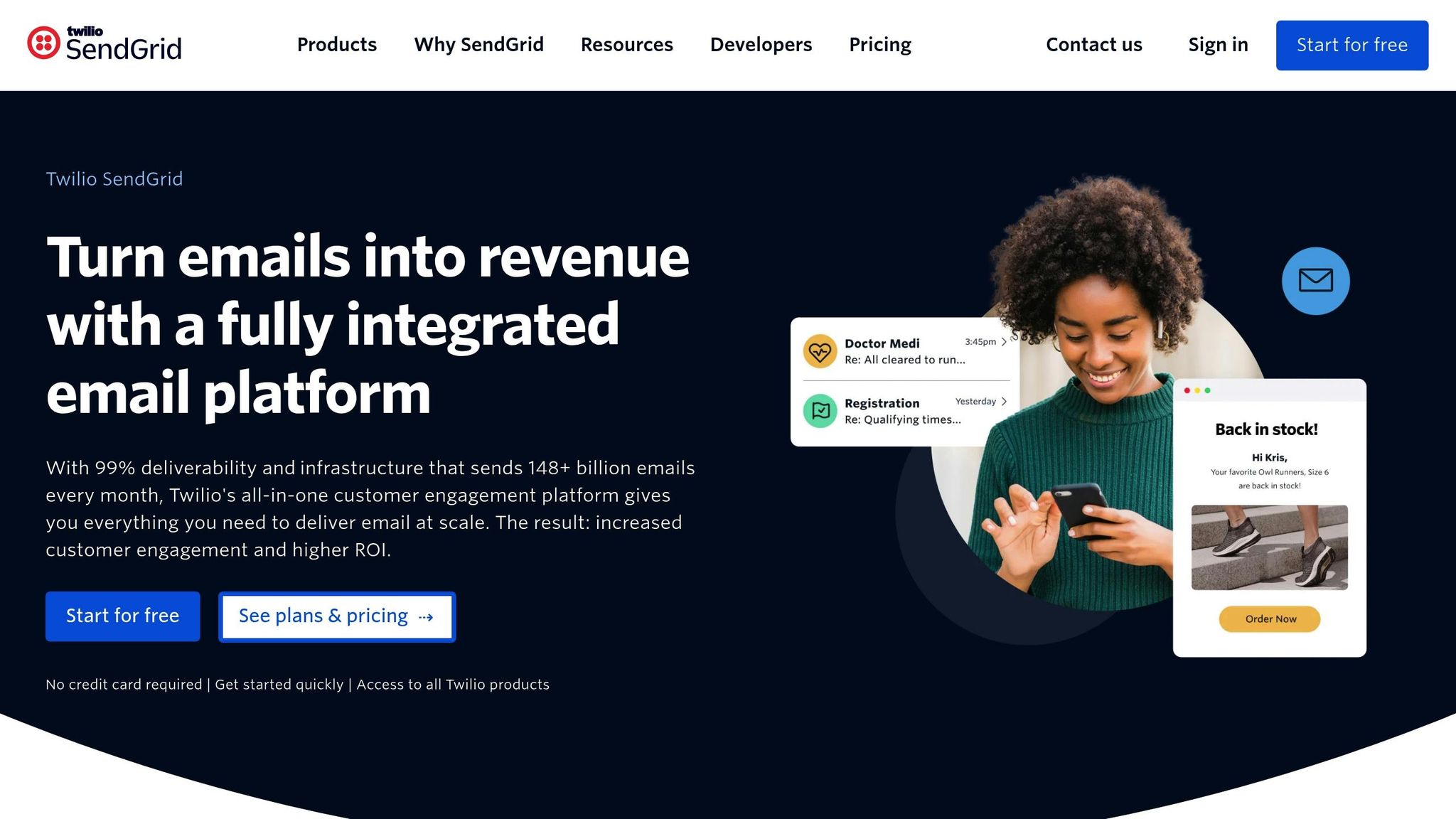
SendGrid, a product of Twilio, is a powerhouse for high-volume transactional emails, catering to developers and enterprises alike. With the capacity to process over 60 billion emails monthly and handle up to 30,000 emails per second, it’s built for reliability, boasting a 99.984% uptime - a crucial feature for mission-critical applications.
API Documentation Quality
SendGrid’s API documentation strikes a balance between simplicity and depth, making it approachable for both beginners and seasoned developers. It features interactive tools where developers can input their API key, test code in real time, and receive immediate feedback. The documentation is thoughtfully organized into sections like quickstart guides, a code exchange, a detailed API reference, and interactive examples. It also includes regular blog updates for additional insights. Each API endpoint is thoroughly explained, with detailed parameters, sample responses, and descriptions. For clarity, the documentation is divided into three main categories: "For Developers" resources, UI documentation, and API reference materials. The Email API supports RESTful APIs and SMTP relay, offering flexibility across various programming languages and frameworks.
Integration Breadth
SendGrid Marketing Campaigns integrates seamlessly with third-party tools, enabling efficient data sharing. Popular automation platforms like Zapier connect SendGrid with applications such as Salesforce, streamlining tasks like sending messages and triggering campaigns based on Salesforce record updates. Beyond that, SendGrid partners with major cloud providers, including AWS, Google Cloud, Heroku, IBM Cloud, and Microsoft Azure. For businesses needing custom solutions, platforms like UI Bakery facilitate advanced SendGrid integrations for tasks like data manipulation, search functionality, and user management. Setting up these integrations typically requires both a SendGrid Marketing Campaigns account and an account with the chosen integration platform.
Scalability and Authentication Methods
SendGrid offers a range of Email API plans designed to accommodate businesses of all sizes and email volumes. Here’s a breakdown of the available plans:
| Plan | Monthly Cost | Email Volume | Key Features |
|---|---|---|---|
| Free Trial | $0 | 100 emails/day for 60 days | Basic sending capabilities |
| Essentials | Starting at $19.95 | 50,000 - 100,000 emails/month | Standard features |
| Pro | Starting at $89.95 | 100,000 - 2,500,000 emails/month | Advanced features, SSO |
| Premier | Custom pricing | High-volume needs | Dedicated support, custom features |
Higher-tier plans include dedicated IP addresses, giving users better control over sender reputation and email deliverability. The Pro and Premier plans also provide single sign-on (SSO) for enhanced enterprise security.
When it comes to security, SendGrid employs two-factor authentication and TLS encryption to protect accounts. API keys are the primary method of authentication, offering a more secure alternative to traditional username-password combinations. It also supports SMTPS using TLS on ports 25, 587, and 2525, and SSL on port 465. Additional security features include:
- IP Access Management: Controls access at the network level.
- Domain Authentication (SPF/DKIM): Prevents email spoofing.
- Subuser Management: Allows segmentation of mail streams and environments.
SendGrid encourages best practices like regular API key rotation, IP whitelisting, and using minimal permission settings to ensure security remains robust.
Next, we’ll take a closer look at Maileroo’s API integrations.
9. Maileroo
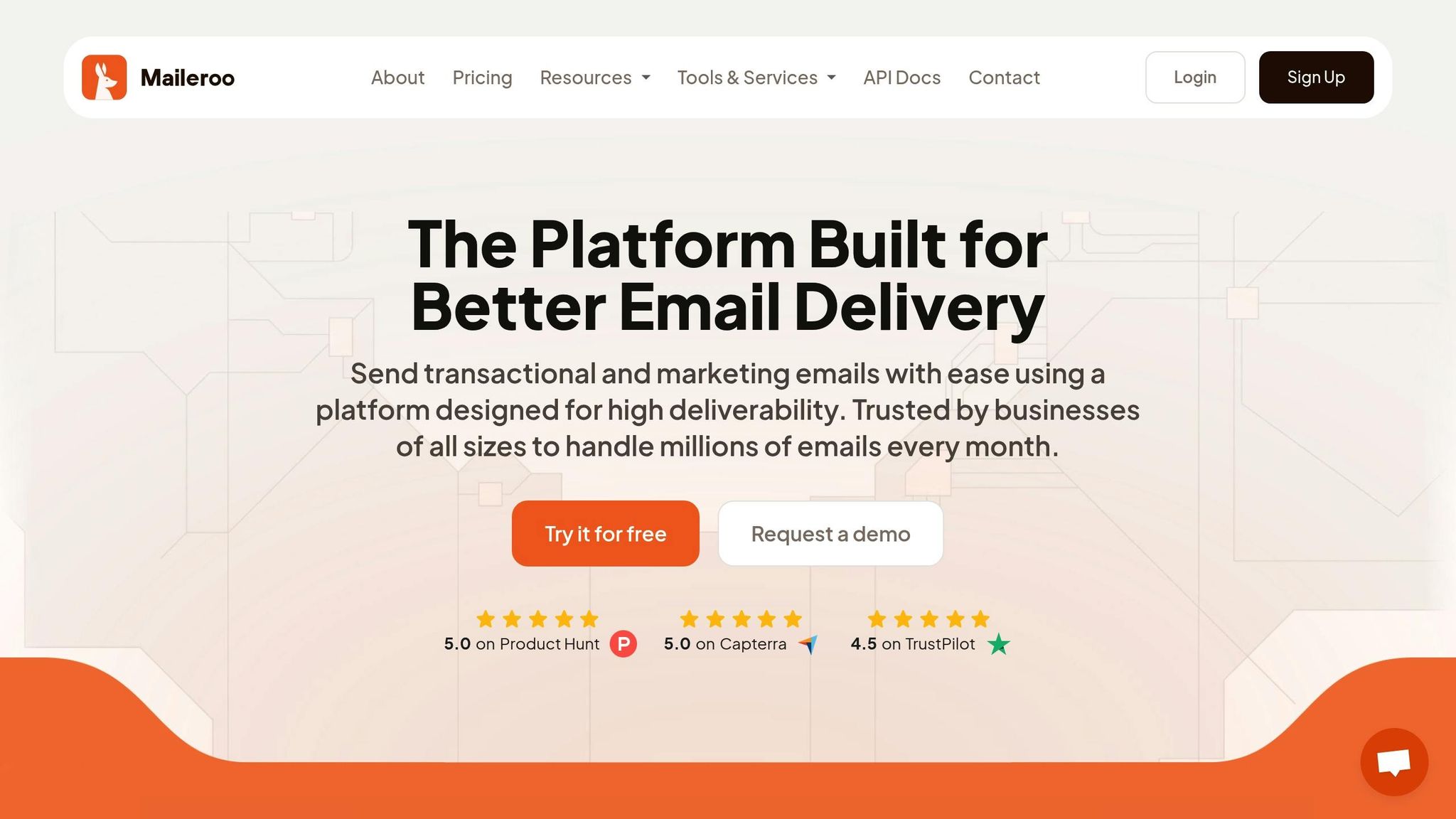
Maileroo is an email platform built around an API-first approach, combining ease of use with high performance. Designed to handle millions of emails each month while maintaining an impressive 99.99% uptime, it has earned top ratings on platforms like Product Hunt, Capterra, and TrustPilot. Let’s take a closer look at what makes Maileroo stand out, starting with its API documentation.
API Documentation Quality
Maileroo’s API documentation is a developer-friendly resource, offering clear and detailed guidance. It covers four key areas: SMTP details, Email Sending API, Contacts API, and Email Verification API. The documentation is structured for quick integration and includes code examples in multiple popular programming languages.
"Dive into our comprehensive docs and guides, and you'll be up and running in no time."
This level of clarity ensures that developers can start sending emails within minutes of setup.
Scalability and Authentication Methods
Beyond its user-friendly documentation, Maileroo delivers scalable performance and secure integrations. Its pricing structure is designed to grow with businesses, starting with a free plan that includes 3,000 emails per month. Paid plans are available for higher email volumes, such as $10 per month for 25,000 emails or $250 per month for 1,000,000 emails:
| Plan | Monthly Cost | Email Volume |
|---|---|---|
| Free | $0 | 3,000 emails |
| Starter | $10 | 25,000 emails |
| Enterprise | $250 | 1,000,000 emails |
For businesses sending over 100,000 emails per month, dedicated IP addresses can be added for $50 per month.
Maileroo supports both SMTP relay and HTTP API methods for sending emails. To enhance security and deliverability, it uses authentication protocols like SPF, DKIM, and DMARC, which verify sender identity and ensure emails land in inboxes rather than spam folders. Additionally, Maileroo operates servers in Germany and the Netherlands to comply with GDPR requirements, and it provides real-time analytics and detailed reporting to help users track and optimize their campaigns.
Users frequently highlight these technical features in their reviews. Vincent Turner, Founder of UNO, shared:
"I've been through a number of mail services over the last few years and Maileroo is a standout for me. Everything about it. The underlying service is great, the architecture is solid and it’s super reliable and delivery is fast."
Aarón Blanco Tejedor, CEO of Ubuntu Productions, also praised the platform’s ease of use:
"My experience has been outstanding. The instructions for adding domains are straightforward and easy to follow. Domain verification is incredibly quick after updating the DNS records, and emails are sent promptly without ending up in spam folders."
With these features, Maileroo sets a strong foundation for seamless email management, paving the way for a deeper dive into Campaign Monitor’s integration capabilities.
10. Campaign Monitor
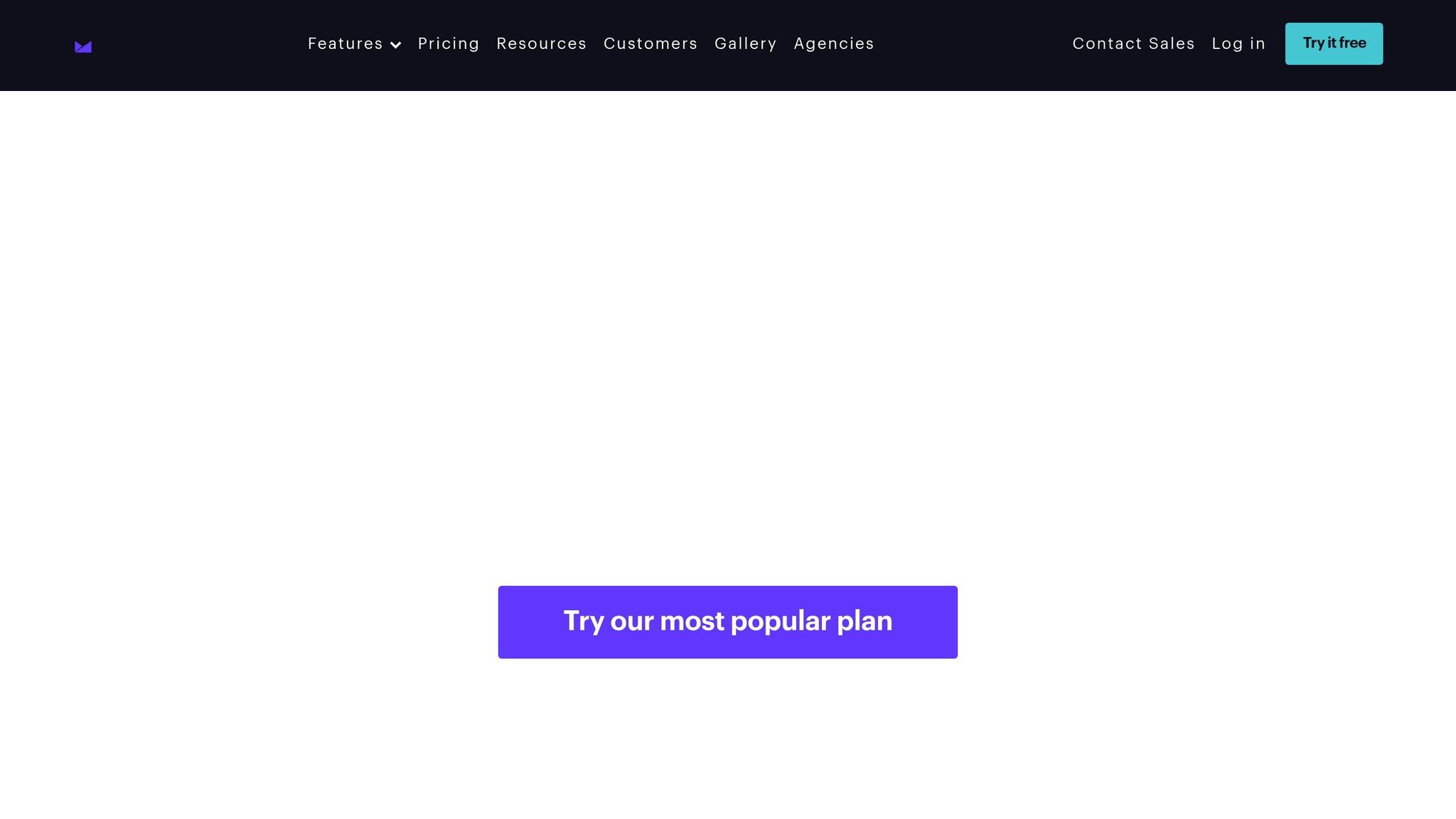
Campaign Monitor wraps up our list as an email platform that blends visually striking email designs with dependable API capabilities. Known for its ease of use and seamless integration options, it’s a go-to choice for businesses aiming to create engaging campaigns while maintaining technical flexibility.
API Documentation Quality
Campaign Monitor’s API documentation is built on a RESTful architecture, making it developer-friendly and easy to navigate. It uses JSON as the standard format for both requests and responses, streamlining data exchange and reducing complexity for developers.
The platform operates on API version 3.3 and enforces TLS v1.2 for all connections, ensuring secure and efficient communication.
"The Campaign Monitor API opens up a world of possibilities for integrating our platform with your favorite CMS, blog, or other third party software." – Campaign Monitor
The API covers key areas like account management, campaigns, lists, subscribers, templates, and webhooks. Additionally, Campaign Monitor offers API wrappers to simplify tasks like authentication and request handling, helping developers save time and effort.
Integration Breadth
Campaign Monitor supports a wide array of third-party integrations, making it adaptable to various business needs. It offers pre-built connections for popular platforms like Salesforce, WordPress, and Shopify. Plus, its Zapier integration extends its reach to thousands of additional apps.
Its Salesforce integration stands out as a top-tier feature. Recognized as the #1 email marketing app on Salesforce, this integration allows users to view email statistics directly within Salesforce, map Campaign Monitor fields with Salesforce data, and automatically add subscribers without manual intervention. In March 2023, Beaufort12’s Campaign Monitor for Salesforce update further enhanced these capabilities.
| Integration Category | Example Platforms | Primary Use Cases |
|---|---|---|
| CRM | Salesforce, Raiser's Edge NXT, Lexer | Syncing customer data and viewing email stats in CRM |
| E-commerce | Shopify | Creating targeted campaigns from customer data |
| Website Tools | WordPress, Unbounce, OptinMonster | Growing email lists through signup forms |
| Advertising | Facebook Lead Ads, AdRoll | Automating SMS communication and retargeting |
This broad integration network is backed by scalable authentication and high-performing APIs, ensuring smooth operations for businesses of all sizes.
Scalability and Authentication Methods
Campaign Monitor supports both OAuth and API key authentication, offering flexibility based on developer preferences. To manage API usage effectively, the platform includes rate-limiting information within HTTP response headers.
It also integrates with tools like Make and Cyclr, further expanding its usability. Unlike platforms that focus on multi-channel systems, Campaign Monitor keeps its API centered on email marketing, making it straightforward without unnecessary complexity.
Webhook support is another highlight, enabling real-time synchronization for subscriber list events. This feature is particularly beneficial for businesses that rely on immediate updates, such as e-commerce brands running time-sensitive campaigns or managing dynamic customer segments.
Campaign Monitor strikes a balance between elegant design and technical reliability. By focusing on ease of use and straightforward implementation, it caters to businesses seeking efficient, visually appealing email marketing solutions.
Platform Comparison Table
Below is a concise comparison table summarizing the core API features of ten leading platforms. This quick reference highlights their authentication methods, documentation quality, SDK availability, and primary integration strengths.
| Platform | Authentication Methods | Documentation Quality | Available SDKs | Primary Integration Strengths |
|---|---|---|---|---|
| Moosend | API Keys, OAuth 2.0 | Comprehensive with code samples | JavaScript, PHP, Python | E-commerce platforms, CRM systems |
| MailerLite | API Keys | Well-structured with examples | PHP, Python, Ruby, JavaScript | Website builders, landing page tools |
| ActiveCampaign | API Keys | Detailed with use cases | PHP, Python, Ruby, Node.js | CRM integrations, marketing automation |
| Mailchimp | OAuth 2.0, API Keys | Extensive with interactive tools | Python, Ruby, iOS, Android | Social media, e-commerce, analytics |
| HubSpot | OAuth 2.0, API Keys | Comprehensive developer portal | Multiple languages available | CRM, sales tools, content management |
| Constant Contact | OAuth 2.0, API Keys | Good with practical examples | REST API compatible | Small business tools, event management |
| Sendinblue (Brevo) | API Keys, OAuth 2.0 | Good documentation | cURL, Node.js, PHP, Laravel, Python, Ruby, Go, Java | Multi-channel marketing, SMS integration |
| SendGrid | API Keys, Bearer Auth | Comprehensive documentation with tutorials | C#, Go, Java, NodeJS, PHP, Python, Ruby | Transactional emails, deliverability tools |
| Maileroo | API Keys | Clear and concise | REST API compatible | Developer-focused integrations |
| Campaign Monitor | OAuth, API Keys | RESTful architecture, developer-friendly | API wrappers available | Salesforce, design tools, webhooks |
The sections below delve into authentication methods, SDK support, and documentation quality to help you identify the platform that best aligns with your technical requirements.
Technical Features and Support
Authentication methods play a key role in determining API security. According to Reuters, OAuth 2.0 is widely regarded as the most secure standard for API authentication, as it allows third-party access without exposing user credentials. On the other hand, API Keys are simpler to implement but offer less security compared to OAuth 2.0. Many platforms, like HubSpot and Mailchimp, provide both options to accommodate varied integration needs.
When it comes to SDK support, platforms like SendGrid and Mailchimp stand out. SendGrid offers official SDKs in multiple programming languages, including C#, Go, Java, NodeJS, PHP, Python, and Ruby. Similarly, Mailchimp provides client libraries for its Marketing API and Transactional API in Python and Ruby, along with mobile SDKs for iOS and Android. This broad language support makes it easier for developers to integrate these platforms into different environments.
Documentation and Integration Analysis
SendGrid is often recognized for its detailed documentation, which includes tutorials and responsive support. Each platform focuses on specific integration strengths to meet diverse marketing and CRM requirements. For example, Moosend excels in e-commerce and CRM integrations, while Sendinblue (Brevo) is optimized for multi-channel marketing and SMS tools.
Conclusion
Strong API integrations play a critical role in scaling email marketing efforts in the U.S. They allow businesses to seamlessly sync customer data, enabling smarter, data-driven decisions that can dramatically improve marketing outcomes.
The numbers speak for themselves: companies using APIs experience a 12% boost in market value, and over 40% of developers report increased revenue as a direct result of API implementations. This goes far beyond convenience - it’s about staying competitive in an ever-evolving digital landscape.
"APIs are the silent engines of digital transformation... By thinking strategically about APIs, companies can scale with confidence, integrate effortlessly, and innovate continuously in a rapidly changing digital landscape." – Irsan Buniardi, Dartmedia
APIs empower email marketing with real-time automation, such as personalized email and SMS triggers, advanced campaign optimization, and streamlined workflows. They also help eliminate data silos by connecting email platforms with CRM systems, e-commerce tools, and other essential software.
The platforms discussed - like SendGrid with its developer-friendly tools or HubSpot with its robust CRM integrations - highlight how different API strategies can meet varying business needs. Whether you're a startup looking for basic automation or a large enterprise requiring complex multi-channel solutions, the right API can turn email marketing into a powerful growth driver.
When choosing an API, focus on key factors like security (encryption and authentication protocols), scalability to manage increasing email volumes, and compatibility with your current tech stack. Regularly monitor API performance to address potential issues early, and rely on detailed documentation and SDK support to streamline implementation and reduce maintenance overhead.
For those ready to explore tools listed in the Email Service Business Directory, these API-powered platforms offer more than just email functionality - they provide a scalable, data-driven foundation for meaningful customer engagement.
FAQs
How can I choose the right email platform with API integrations for my business?
To pick the right email platform with API integrations, start by pinpointing your business needs. Consider factors like how many emails you send, the features you absolutely need, and the tools you plan to connect with.
When evaluating platforms, focus on API reliability, how easily it integrates with your existing systems, its ability to grow with your business, and the level of developer support it offers.
Once you’ve got a clear list of requirements, compare top platforms known for their strong API performance. Choose one that meets your technical needs, fits your budget, and has the flexibility to scale as your business expands. A thoughtful selection process can simplify your email marketing and set you up for long-term success.
What security measures should I consider when using API integrations with email platforms?
When working with API integrations for email platforms, keeping your data secure and blocking unauthorized access should be top priorities. Start by using strong authentication methods such as OAuth or token-based access controls. Make sure API keys and tokens are encrypted and stored safely to avoid potential breaches.
Use role-based permissions to restrict access, ensuring users only have the level of access they need. It's also important to regularly monitor API activity, enable detailed logging, and apply rate limiting to identify and stop any misuse or suspicious activity. These steps create a safer and more reliable API setup for your email marketing operations.
How do API integrations make email marketing campaigns more scalable and efficient?
APIs play a key role in making email marketing campaigns more efficient and manageable. By automating repetitive tasks - like sending personalized emails triggered by specific user actions or conditions - they simplify workflows, save time, and ensure timely communication with your audience.
On top of that, APIs enable smooth data sharing between platforms. This allows you to create campaigns that feel more tailored and relevant to your recipients, leading to higher engagement, better customer experiences, and improved ROI. Plus, with their modular approach, APIs let you expand your tools and features without needing to overhaul your current systems. This keeps costs in check and ensures your operations run smoothly.


